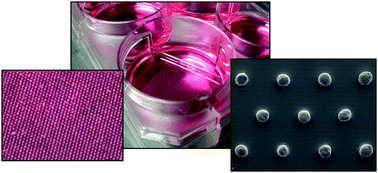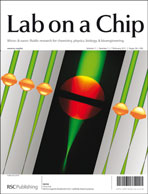Microarrays for the scalable production of metabolically relevant tumour spheroids: a tool for modulating chemosensitivity traits†
Abstract
We report the use of thin film poly(dimethylsiloxane) (PDMS) prints for the arrayed mass production of highly uniform 3-D human HT29 colon carcinoma spheroids. The spheroids have an organotypic density and, as determined by 3-axis imaging, were genuinely spherical. Critically, the array density impacts growth kinetics and can be tuned to produce spheroids ranging in diameter from 200 to 550 µm. The diffusive limit of competition for media occurred with a pitch of ≥1250 µm and was used for the optimal array-based culture of large, viable spheroids. During sustained culture mass transfer gradients surrounding and within the spheroids are established, and lead to growth cessation, altered expression patterns and the formation of a central secondary necrosis. These features reflect the microenvironment of avascularised tumours, making the array format well suited for the production of model tumours with defined sizes and thus defined spatio-temporal pathophysiological gradients. Experimental windows, before and after the onset of hypoxia, were identified and used with an enzyme activity-based viability assay to measure the chemosensitivity towards


 Please wait while we load your content...
Please wait while we load your content...